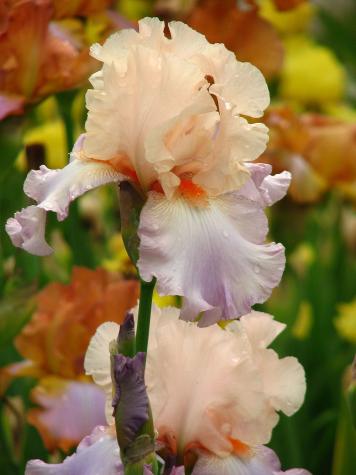COLUMBIA, Mo. – Few flowering perennials provide more enjoyment for less effort than iris. With colorful blooms that rival those of orchids in intricacy, irises grow easily in the garden. Seemingly, without a care in the world, they rarely require the gardener’s attention to thrive.
However, gardeners should give the carefree beauty some attention in August. By dividing and replanting clumps that have become too large, gardeners can increase spring displays of the bearded beauty, said University of Missouri Extension horticulturist David Trinklein.
“Iris” comes from the Greek word meaning rainbow. Indeed, few flowers come in as many colors or bring such joy on a spring day, Trinklein said.
Unfortunately, when iris clumps become large and overcrowded, they bloom less.
Clumps can be rejuvenated by dividing the rhizomes into small sections. A rhizome is a thickened stem that grows horizontally at ground level or just below the soil’s surface, said Trinklein. They grow slowly during July and August. Dig, divide and transplant during these months.
Divide irises every three to four years. Trinklein prefers a sharp knife to trowels, spades or dull knives, which may open wounds that allow disease to enter. Disease-infected rhizomes should be separated from healthy roots to prevent the spread of disease.
“Division of iris is the only way to propagate the plant to insure that new plants are genetically the same as the parent plant,” said Trinklein. Iris can be produced from seeds, but color and form may differ and disappoint.
Tall bearded irises include a class known as reblooming irises. These cultivars bloom both in the spring and fall. They need regular division to rebloom, Trinklein said. Do not expect blooms in the fall right after you divide clumps in August.
When planting, place rhizomes horizontally at the soil’s surface. Rhizome tops should be visible when planted properly. Spread out roots and point them downward. Three rhizomes may be set close together so they radiate outward if they are small. Space rhizomes 18 to 24 inches apart.
Cut back leaves to 2-3 inches when replanting. This is especially important if iris leaf spot, a common disease that weakens and disfigures plants, is present.
Keep your iris bed clean, Trinklein advised. Gather up and pull off any dead or diseased leaves. Before flowering, apply a fungicide containing chlorothalonil or thiophanate-methyl as its active ingredient to prevent or reduce iris leaf spot. Follow label directions when using any pesticide.
Bacterial soft rot is another common iris disease. The leaf base and rhizome of infected plants develop into a soft, rotten mass with a foul odor. Dig and destroy infected plants and remove them from the garden. Trim damaged rhizomes back to sound, healthy tissue and expose to the sun for at least two days before replanting. Do not replant iris back into the spot where the diseased plant was located.
Iris borer is an insect that feeds on the rhizomes of iris and may help spread soft rot. Clean up debris and dead leaves in late fall and very early spring to reduce the number of the eggs of iris borer. Also, use an insecticide labeled for iris borer control (such as acephate or spinosad) near bloom time to prevent borer damage on leaves and rhizomes.
Look for a new location for irises that do not flower well. Iris requires sun and well-drained soil. Irises do not grow well in shady areas. This makes them subject to diseases and other problems. High soil fertility is not required, but irises benefit from a complete fertilizer high in phosphorus and potassium and lower in nitrogen.
More information about iris care can be found on American Iris Society website.
Photo
Bearded iris
For ancient Egyptians, iris’ three petals symbolized faith, wisdom and valor. The upright petals are known as standards. The three drooping sepals are called falls. The bushy “beard” on the falls adds interest to this popular plant. Photo by Andrey Korzun. Shared under a Creative Commons license (https://creativecommons.org/licenses/by-sa/3.0), via Wikimedia Commons.
